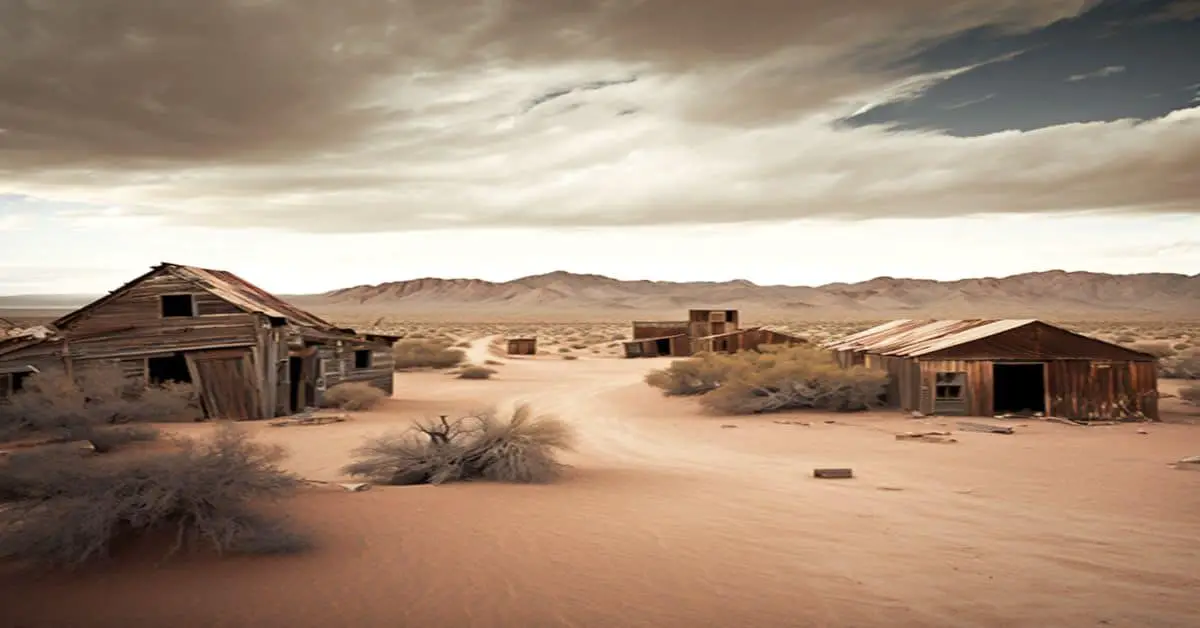Hidden away in the California countryside lies a forgotten ghost town that bears testament to the state’s Gold Rush era. La Grange, once known as French Bar, was a thriving trade center by 1855 and served as the county seat until 1862. It is now a relic of a bygone era, with only two large stone buildings, a wooden IOOF hall, and an old adobe P.O. remaining as a reminder of its once bustling population of 4,000-5,000 residents.
Despite its obscurity, La Grange is a fascinating destination for history enthusiasts and anyone interested in the Gold Rush era. The remains of the town offer a glimpse into the past, taking visitors on a journey through time to when the town was at the height of its prosperity.
In this article, we will explore the history and origins of La Grange, delve into its population and infrastructure during its heyday, and examine the remains and attractions that make it a must-visit destination for anyone interested in California’s Gold Rush history.
Key Takeaways
- La Grange was established in 1852 by French miners and became the county seat in 1855.
- The town’s economy was driven by mining, agriculture, and trade, and its population peaked at 4,000-5,000 residents.
- The floods in 1856 and the discontinuation of the ferry service in the early 1880s led to a decline in economic activity and population, and the town’s population declined further as gold mining in the area dwindled and the railroad bypassed the town.
- Today, La Grange is a ghost town with only a few full-time residents, but its remains and attractions offer a fascinating glimpse into California’s history, including two large stone buildings, an old adobe P.O., and the La Grange Museum. Visitors can also enjoy the natural beauty of the area, including the Merced River, the nearby La Grange Dam and Reservoir, and the rolling hills, lush forests, and tranquil rivers.
History and Origins
La Grange, originally known as French Bar, was established by French miners in 1852. The settlers named the town after themselves and established a thriving trade center by 1855.
At its height, La Grange had a population of 4000-5000 residents and was served by three stage lines. The town also became the county seat, transferring the title from Empire City in 1855. However, the county seat was transferred again in 1862 after only 29 votes settled the issue.
The town’s economy was driven by mining, agriculture, and trade. La Grange’s location along the Tuolumne River made it an ideal location for transportation and trade. The town was home to several businesses, including the John Talbot Co.’s flour mill. Unfortunately, the mill was washed away in a flood in 1856.
Despite the town’s early success, La Grange’s population declined after the gold rush ended. Today, only a few full-time residents still live in La Grange, but the town remains an important part of California’s history.
Population and Infrastructure
At its peak, the town’s population consisted of thousands of residents and was served by multiple stage lines. At the same time, its infrastructure included 2WD roads, a flour mill, and a ferry that operated for over two decades.
Despite the thriving economic activity in the town, transportation challenges were evident. The floods that washed away the flour mill in 1856 and the discontinuation of the ferry service in the early 1880s had a significant impact on the town’s economic activity, leading to a decline in the population.
The economic factors also played a role in the decline of La Grange. As gold mining in the area dwindled and the railroad bypassed the town, La Grange lost its prominence as a trade center. As a result, the county seat was transferred to other towns, and the population dwindled further.
Today, only a few full-time residents still live in La Grange, and while the town’s infrastructure has changed, its history and remains continue to attract visitors who are interested in exploring California’s history.
Remains and Attractions
Exploring Ruins, Hidden Gems: La Grange’s Remains and Attractions
The remains of the once-thriving trade center in Stanislaus County include two large stone buildings, a wooden IOOF hall, and an old adobe P.O., which continue to attract visitors interested in exploring the area’s rich history. The stone buildings, which used to house the courthouse and jail, are particularly impressive with their sturdy construction and intricate carvings.
The IOOF hall, built in 1878, was a meeting place for the International Order of Odd Fellows, a fraternal organization. Its wooden structure, with its unusual shape and ornate details, is a testament to the skilled craftsmanship of the time.
The old adobe P.O., which was once the post office, is a reminder of the importance of communication and mail delivery in the past.
Visitors to La Grange can also enjoy the natural beauty of the area, with its rolling hills, lush forests, and tranquil rivers. The Merced River, which runs through the town, is a popular spot for fishing, swimming, and kayaking.
The nearby La Grange Dam and Reservoir also offer opportunities for boating and water sports. For those interested in history, the La Grange Museum, located in the town’s former IOOF hall, provides a fascinating glimpse into the past with its collection of artifacts, photographs, and documents.
Overall, La Grange’s remains and attractions offer a unique and memorable experience for visitors exploring California’s forgotten ghost town.
Frequently Asked Questions
What caused the decline of La Grange as a thriving trade center?
The decline of La Grange as a trade center was caused by the depletion of gold and silver mines in the area, competition from nearby towns, and the rerouting of transportation routes. Its historical significance is preserved through efforts to maintain the remaining stone buildings and wooden IOOF hall.
Are there any ghost stories or legends associated with La Grange?
Like the still waters of a forgotten lake, La Grange offers no tales of ghostly sightings or supernatural occurrences. Its history remains rooted in its once-thriving trade center, now a ghost town.
What was the racial and ethnic makeup of La Grange’s population during its peak years?
During La Grange’s peak years, its population diversity consisted mainly of European immigrants, including French, Chinese, and Mexican settlers. Cultural influences were evident in the town’s architecture, food, and traditions.
Were there any notable events or incidents that occurred in La Grange during its history?
Notable incidents in La Grange include transferring the county seat from Empire City, settled by 29 votes, and the 1856 flood that washed away the John Talbot Co. flour mill. Famous residents are unknown.
The few full-time residents in La Grange face challenges such as limited access to amenities and services, and the need to maintain aging infrastructure. However, they receive community support from local organizations and volunteers who help preserve the town’s historical and cultural significance.


